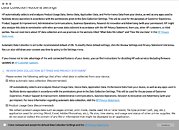Monday, September 16th 2019

HP Printers Try to Send Data Back to HP
Recently in a form of a blog post, software engineer called Robert Heaton, explored the installation and setup of a regular HP printer. However, during the installation process, he found out some alarming things hidden in the install software. When going through the setup process he found a headline called "Data Collection Notice & Settings" where HP states that it tries to collect and send the data you put through the printer back to HP, for purpose of improving advertisement, customer experience, etc.
The software installation began as any normal install, with a "subscribe to our printer ink replacement program" advertisement at the beginning, which is okay because its the way HP supports customers with required ink after the stock one is used up. What seemed off was, in fact, the aforementioned "Data Collection Notice & Settings" part. Here HP intentionally hides the parts which are very important when choosing what information you plan to send back. Instead of immediately being spotted, the list is hidden so a person who isn't very tech-savvy can easily skim through without noticing the little details, making the person consent with data collection. Additionally, the "feature" is turned on by default, but end users can opt in to disable it.What printer collects is the data from all your apps that make documents. Basically the type of document you are printing (.pdf, .jpeg etc.), time stamps, document size and usage report. HP's privacy statement states that HP doesn't scan the content of documents you are printing, just its features and specifications. Even through your personal data is claimed to be intact, sending data reports isn't just a small thing to ignore.
Source:
Robert Heaton Blog
The software installation began as any normal install, with a "subscribe to our printer ink replacement program" advertisement at the beginning, which is okay because its the way HP supports customers with required ink after the stock one is used up. What seemed off was, in fact, the aforementioned "Data Collection Notice & Settings" part. Here HP intentionally hides the parts which are very important when choosing what information you plan to send back. Instead of immediately being spotted, the list is hidden so a person who isn't very tech-savvy can easily skim through without noticing the little details, making the person consent with data collection. Additionally, the "feature" is turned on by default, but end users can opt in to disable it.What printer collects is the data from all your apps that make documents. Basically the type of document you are printing (.pdf, .jpeg etc.), time stamps, document size and usage report. HP's privacy statement states that HP doesn't scan the content of documents you are printing, just its features and specifications. Even through your personal data is claimed to be intact, sending data reports isn't just a small thing to ignore.


65 Comments on HP Printers Try to Send Data Back to HP
But like we both said, 95/98 don't hold a candle to 10.
For instance, you probably wouldn't be running KDE on a supercomputer but you would on a desktop. Your average download-and-install distros of Linux like Ubuntu and Mint have general-purpose built versions of the Linux kernel. You wouldn't have that same kernel running on an Android device. The point I'm driving at is though Linux can be a general-purpose OS, it's generally custom-built for the task at hand.
Haven't bought any HP hardware in two decades and don't plan to start now. Brother has been better in every way (cheaper ink, lean drivers, cheaper initial cost, long operational life, etc.)
But let's try to get back on topic ;)
Remember, kids... running over grandma isn't okay just because someone else runs over grandma and shoots the dog.
2) It's only a paltry bit of unimportant information.
a) Imagine a giant hierarchical chart, one that tracks all of the spying that's done on a person — let's say you. Now, not only do you have to take immense pains to get enough data to create that chart, you need to memorize it or keep it at the ready which means keeping it in your mind at the expense of other things. To top it all off, you have to constantly add, subtract, and adjust the inclusions, rankings, and understandings of all of those things on that chart.
b) Meanwhile, in a different world, the same person just has all of the stuff they buy and use and it's not spying on them. They have no need of that chart, at least the huge amount of it that covers spying by electronic devices you've paid for.
If you have time and energy to waste, I suppose you can enjoy a). I think the majority of people would prefer to not be enslaved by this burden. Somehow they might prefer getting what they thought they were buying instead of a giant time/energy-sucking vortex, a burden to shoulder.
3) As has been pointed out, how benign data is on its own is one thing but how benign it is when combined with more spying is another.
4) Corporations and the people who created the concept of the corporation are masters at hiding the true price of things. When you accede to these kinds of slimy practices you are helping them to obfuscate the cost, to you and to the world.
It's just that every company wether it's an app all the way to OS is using a form of telemetry. Do things get better ? No, at least not in my opinion. They should stick to what it's intended for, and not share contacts, voices, whatever that's completely irrelevant to the workings of a OS or app in the first place.
Adobe started to add telemetry as well. Why? Their products worked seamless in the past. And NOW it needs TM in order to have it's features running.
I'm paying for their software, and a bunch of other things as well. It still crashes tho when you load a bunch of crap compiled HTML code with weird behaviour.
Anyway: there are quite a few updates on Windows 10 causing a BSOD. What good is telemetry if one of your (beta testers, lol) cant properly get back into the OS? Here, a fresh one: www.tomshardware.com/news/windows-10-action-center-network-adapters-not-working-update,40407.html
Again the fact that it reads data directly from the document you are printing should send shivers down your spine, what if you were writing a market analysis, a financial report,your credit card numbers and copying that to send to your employer, business partner, spouse, etc...
Again it's only as anonymous as they want it to be. Heck even Yahoo, Google and Microsoft were caught storing user passwords in data files, not even hashing them, let alone encrypting them.It's only as anonymous as they want it to be, I bet you most of their software engineers can see most of your data, just like various companies and government agencies have been revealed to take a lot more data than advertised and even low level employees often having access to that data. In fact in the NSA even low level agents were spying on their ex gf's wife's.
Again the fact that it reads data directly from the document you are printing should send shivers down your spine, what if you were writing a market analysis, a financial report,your credit card numbers and copying that to send to your employer, business partner, spouse, etc...
Again it's only as anonymous as they want it to be. Heck even Yahoo, Google and Microsoft were caught storing user passwords in data files, not even hashing them, let alone encrypting them.It's only as anonymous as they want it to be, I bet you most of their software engineers can see most of your data, just like various companies and government agencies have been revealed to take a lot more data than advertised and even low level employees often having access to that data. In fact in the NSA even low level agents were spying on their ex gf's wife's.
Again the fact that it reads data directly from the document you are printing should send shivers down your spine, what if you were writing a market analysis, a financial report,your credit card numbers and copying that to send to your employer, business partner, spouse, etc...
Again it's only as anonymous as they want it to be. Heck even Yahoo, Google and Microsoft were caught storing user passwords in data files, not even hashing them, let alone encrypting them.
Try anything else with the NT kernel and I think you'll find it not fairing so hot.
Windows 10 handles multiple audio devices far better than Windows 7 and we're not even getting to Bluetooth devices yet, Windows 10 handles Bluetooth headphones ten times better than Windows 7. Once a pair of Bluetooth headphones are paired to a Windows 10 system, reconnecting to them is an absolute breeze. You simply put your headphones into pairing mode, press Windows Key+K, click your device and it's done. In Windows 7 this is absolute pain, choosing which audio device to output to is also not nearly as easy. The Action Center is also a Godsend as well, notifications (much like a smartphone) go to the Action Center whether it be from your web browser or other programs on your system. Multiple monitor support is also much better on Windows 10 as well since you can put a taskbar on every monitor, not just your primary monitor.
10 has a lot of bugs. They don't bluescreen, they are just odd niggly things like registry searches crashing and settings not "sticking" as intended. If anything, it reminds me of Vista in that way more than anything... a faster, but buggier Vista.